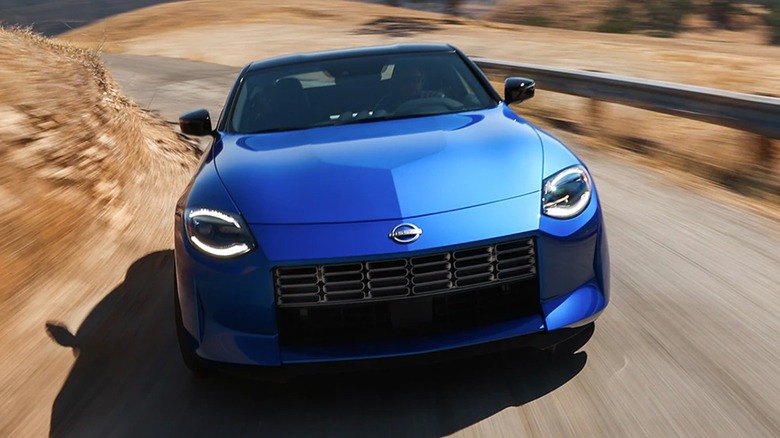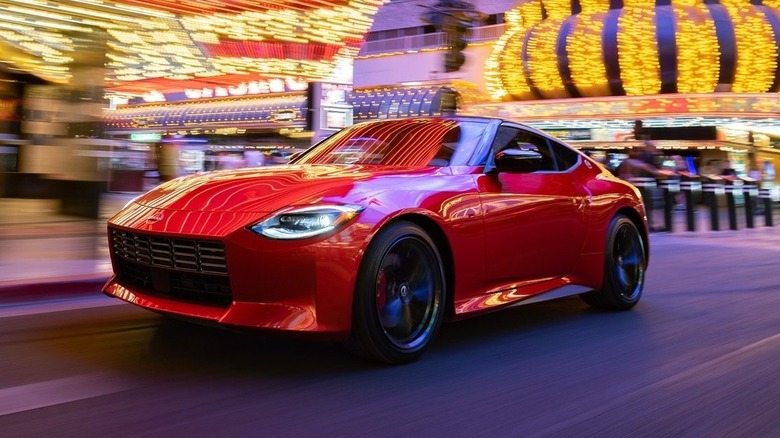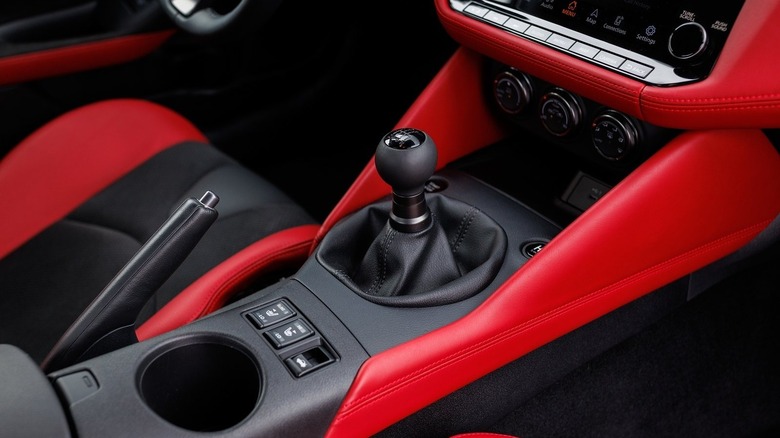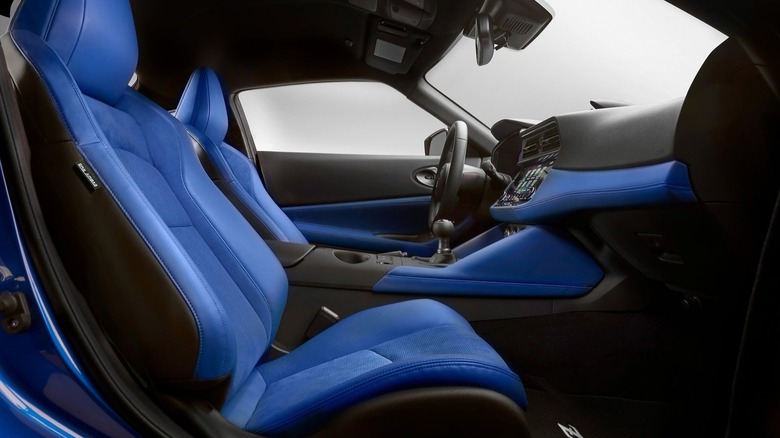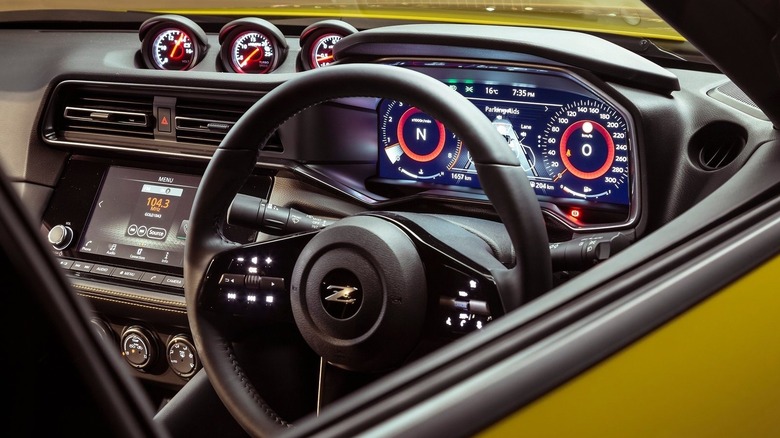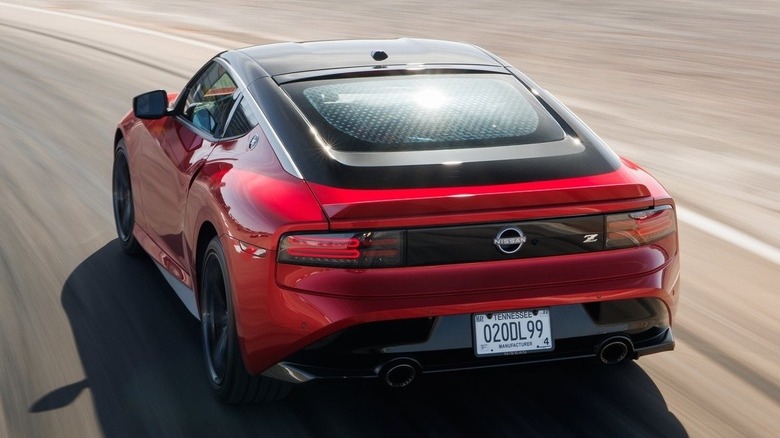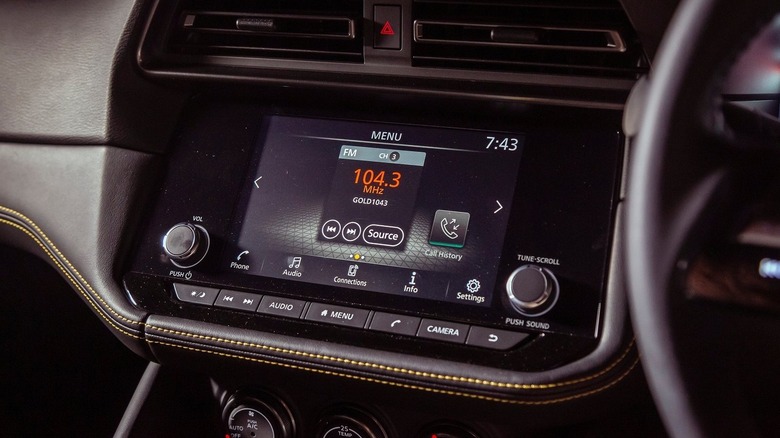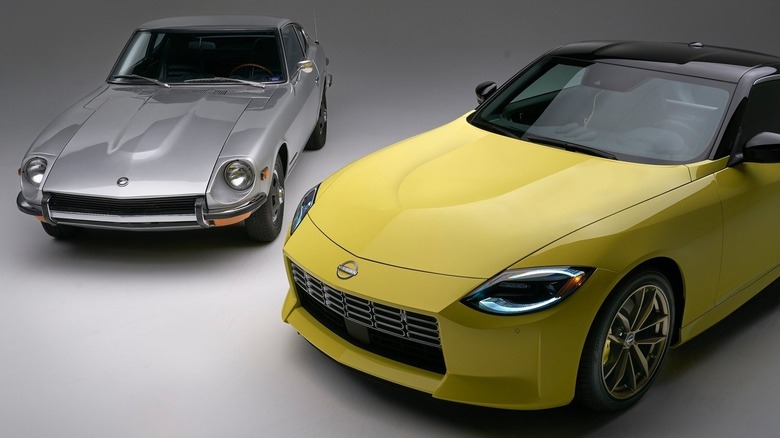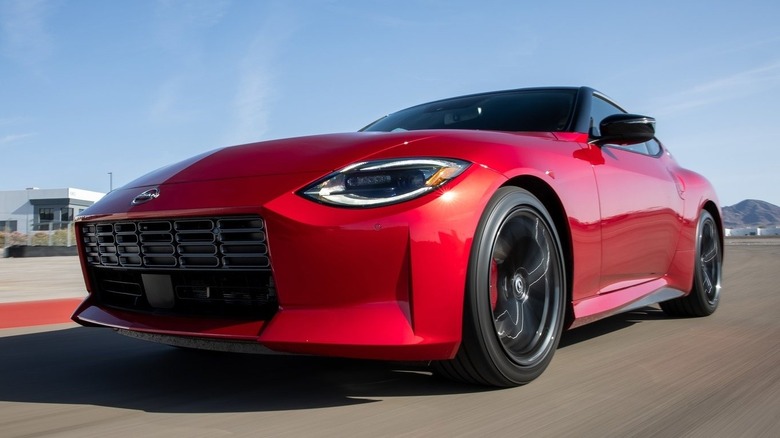The 8 Coolest Features Of The 2023 Nissan Z
The Nissan Z nameplate has a long history that goes back to 1969, when the original Nissan 240Z was released. That car has since become a legend in its own right, as its excellent handling, timeless style, and affordable price tag saw it become a hit across the US and many other international markets, helping to establish the Nissan/Datsun name in the process. Up until the unveiling of the new 2023 Nissan Z, the current generation Z car had been the 370Z. It had plenty of strengths, but by the end of its production run, questions were being asked about whether the car's dated interior and unrefined handling were worth the price of admission. So, it's fair to say that a new Z car was long overdue.
The 2023 Z aims to address the criticisms of the 370Z, but it also needs to compete against its similarly-priced rivals, with the Toyota Supra, Honda Civic Type R, and BMW Z4 all offering compelling alternatives to the Nissan. From what we know so far, the new Z does a great job of holding its own against this tough competition, but the only real way to tell will be when the sales numbers begin to roll in after Nissan starts customer deliveries in a few months time. Until then, it's worth taking a closer look at exactly what the Z offers drivers, and why many enthusiasts can't wait to get their hands on it.
Twin-Turbo V6 Engine
The starting point of any great sports car is its engine, and the Z's seems to have all the right credentials. Only one engine option is available, and it's a 400-horsepower twin-turbo V6 with an aluminum-alloy block and heads to keep weight to a minimum. This makes the Z one of the most powerful cars in its price bracket, with 18 more horsepower than the Toyota Supra and around 80 more than the Honda Civic Type R. The engine is shared with Infiniti's Red Sport cars, but it's been modified extensively for use in the Z. Among other things, there's a new recirculation valve for quicker throttle response and a speed sensor on the turbocharger that allows it to spool up faster.
Those improvements translate to a car that feels markedly quicker to drive on the road than the old 370Z did. SlashGear's Chris Davies recently got to test drive an early version of the Z, and he noted that its plentiful horsepower and lack of electronic trickery gave the Z a more old-school feel than many of its rivals. But, that in itself makes it a rather unique prospect in today's sports car market.
Six-speed manual transmission
There have been plenty of headlines about the manual transmission dying, and while it's not as popular as it used to be, it's far from extinct yet. However, many modern sports cars have chosen to eschew a stick shift in favor of a slicker, more efficient auto box, which is why it's great to see that the new Z still offers both options. A six-speed manual transmission is the purist's choice, but a nine-speed automatic is also available, and it's fast and responsive both on the track and at road-legal speeds.
The nine-speed auto might be the better option of the two in pure performance terms, but a lot of the Z's appeal is based on being a throwback, with its old-school look and driving dynamics. For the full retro-modern experience, the manual transmission remains unbeaten, and besides, pushing 400 horsepower through a stick shift is always going to be a recipe for fun. However, it's worth noting that there have been some accusations that this focus on stick-shift nostalgia is essentially a marketing ploy to disguise the fact that the Z hasn't had a huge amount of development work put into it. In particular, one Top Gear opinion piece called it "the old 350Z formula in some faded retro lipstick and cheap make-up." Ouch. Is it true? Well, perhaps to a degree, but at the very least, the Z gives enthusiasts one last chance to buy a new manual Z car before the transmission is wiped out entirely by the switch to electrification.
Performance seats
A common criticism of the 370Z was that its interior simply didn't match up to that of its rivals, and so with the new Z, Nissan have made a point of emphasizing the changes it's made to the cabin of the car. One of the biggest updates has been the redesigned seats, which Nissan's website rather amusingly describes as "hold[ing] you in ways you never dreamed of." While it's a bit of a stretch to claim that the new Z will redefine the way anyone sees a car seat, it's certainly a noticeable improvement over the previous generation car.
The seats were, according to Nissan, designed with lateral support in mind, and feature an anti-slip material and a slide-reducing center pad in the lower seat cushion to help keep the driver firmly in place. There are also knee bolsters which are designed to work alongside the seat to offer additional support. Top-spec Z models will get leather seats with contrasting yellow stitching and suede accents, while base-spec models will have to make do with a monotone design.
Racing driver-designed gauges
One of the key interior design features on Z cars is the triple gauge cluster, which in the previous generation 370Z displayed oil temperature, voltage, and a clock. In the new Z, these three centrally-mounted pods display boost pressure, turbo speed, and voltage, with the clock and oil temperature readout being moved into the main dashboard. In particular, showing the speed of the turbocharger's turbine is an unusual choice, but it's an interesting novelty even if it's not that useful for most drivers. It was included, Car Bibles suggests, as a way to remind customers about the advanced Garrett FZ5T turbochargers lurking under the hood, one of the key reasons that the car is able to make as much power as it does.
The layout of the gauges and the main instrument cluster was designed with input from Tsugio Matsuda, a racing driver who competes for the NISMO team in the Japanese Super GT championship. The dashboard is entirely digital and can be configured with three different setups, although the Sport Mode screen will be the one that drivers will want to go for at the track or on back roads.
Launch Control
For the first time ever on a Z car, launch control is available on the Performance version of the 2023 Nissan Z. It helps to eliminate wheel spin off the line by adjusting the car's throttle and traction settings for optimal grip. This helps propel the Z to a much faster 0-60 mph time than its predecessors, with an unofficial estimate of around 3.5 seconds in comparison to the 370Z's time between 5.1 and 5.5 seconds. It's one of the very few new bits of electronic assistance that's available with the new car, and although this hasn't been confirmed by Nissan, it's likely that the tech has been adapted from the GTR, which has featured a similar system for over a decade.
Nissan suggests that in addition to improving the overall acceleration of the car, the launch control feature also helps the Z feel more consistent when the throttle is planted. This is perhaps a response to criticism of the previous-generation 370Z, which reviewers claimed could behave inconsistently, making it more difficult to drive smoothly. Whatever the reason for launch control's inclusion, it's a welcome addition and helps give the Z a straight-line performance edge over rivals like the Toyota Supra, which can only manage a 4.3-second 0-62 mph time.
Integrated Infotainment
A lot of attention is usually paid to the performance credentials of a newly-unveiled sports car, and rightly so. But, what's often overlooked is how easy it is to live with and drive every day. This is especially important for mass-market sports cars like the Z. One of the key criticisms of the old 370Z was that it lacked the modern infotainment systems that many of its rivals offered, but the new Z should have no such problems. An eight-inch infotainment display comes as standard, and a larger nine-inch unit with built-in navigation is optional.
The car also comes with a new suite of connectivity features including Apple CarPlay and Android Auto, SiriusXM satellite radio and an optional WiFi hotspot. For audiophiles, a Bose stereo system is optional, otherwise a six-speaker setup is included as standard. These upgraded features might not make headlines in the same way as the 400-horsepower V6 engine has done, but they're just as important for buyers looking to make the car their daily driver, and should help win over some buyers who were put off by the 370Z's archaic infotainment offerings.
Retro-Inspired Design
The Z's exterior design pays homage to the 240Z, the original Z car that helped establish Nissan's reputation as a global sports car manufacturer. In an interview with Road & Track, Nissan's senior vice president for global design, Alfonso Albaisa, said that he wanted the new Z to emulate the hero-car feeling of the 240Z mixed in with the minimalism of the 300ZX. These influences can be seen in the new Z's shape, with a classically-proportioned front end that closely resembles the 240Z when the two cars are put side-by-side. Likewise, the rear of the car features taillights that mirror the design of the Z32 300ZX.
Over 100 initial design proposals were reportedly submitted from design teams around the globe, but the final design was penned by a Japanese team led by Naoyuki Ohkoshi, a Nissan veteran who's spent more than 20 years working for the company. Along with taking inspiration from previous Z models, the designers also worked to incorporate the golden ratio, a mathematical expression that's considered to make things look pleasing to the eye. According to Nissan, elements of the front and rear, window height, and door panel incorporate the golden ratio to "impress a natural beauty and pleasing aesthetic to all."
Affordable starting price
It's all very well having an excellent sports car, but if it's priced so that no one can afford it, then it will never be a commercial success. Nissan has made a point of saying in its marketing material that the new Z starts under $40,000, and while that claim has been repeated by some outlets, it's not entirely true. The car's official list price is $39,990 for a base-spec model, but add in a compulsory $1,025 destination fee and a few hundred extra dollars in dealer fees and it'll be closer to $42,000 in reality. That's still a great price for such a capable car though, and it undercuts rivals like the six-cylinder Toyota Supra by a significant margin.
The higher-spec Z Performance trim comes in at around $51,000 including destination fees, and the top-spec Z Proto Spec model will cost around $54,000, although it's only available in limited numbers. For that price, the Z starts to become less of a bargain, especially since this $10,000+ price increase doesn't translate to an increase in performance figures. The higher-spec Z is almost identical in price to the Supra, and it's not far off the base price of a Porsche Cayman, which offers both superior handling and a more prestigious badge. But, for a healthy dose of nostalgia-fueled driving fun, the 2023 Nissan Z is a very appealing choice, and in base-spec form, it's hard to think of a car that offers better performance at its price point.
